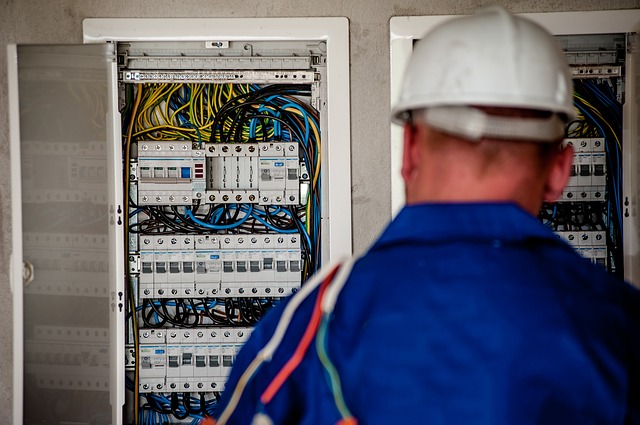Electrical system
Contents |
[edit] Introduction
An electrical system, within the context of a building, is a network of conductors and equipment designed to carry, distribute and convert electrical power safely from the point of delivery or generation to the various loads around the building that consume the electrical energy.
The vast majority of electrical systems used in buildings in the UK operate at 230V single phase alternating current (AC) or 400V 3 phase, at a frequency of 50Hz. These networks are often referred to as low voltage (LV) networks. This system is also referred to as mains electricity.
Larger installations may operate at higher voltages, often with 11kV supplies or feeders at the origin of the installation. These networks are referred to as high voltage (HV) networks.
Power conversion from 11kV networks down to the 230V-400V range is usually undertaken via transformers in a substation.
[edit] Conductors
The conductors that form part of the electrical system are the means by which electricity is transferred from one place to another. Typically, conductors are made from copper, which offers a good balance between electrical conductivity and cost. Aluminium may also be used in some instances. Conductors are typically insulated with PVC or other synthetic insulating materials.
Most conductors are used in the form of electrical cables. These can be run either separately or within containment systems between two points of an electrical system.
Other conductors commonly used in electrical systems in buildings are busbars. These are usually copper or aluminium conductors and run within an insulating and safety enclosure, typically a trunking. These may be used where larger conductors are required, as the busbar trunking is often physically smaller than cables of equivalent current carrying capacity. Such busbar trunking is usually made up of rigid lengths, and may have several tapping points, where supplies may be tapped or branched off.
[edit] Switchgear
As well as conductors, an electrical system will also comprise equipment that provides switching and protection capabilities, known as switchgear. Switchgear enables with manual or automated control of current flow.
Manual control relies on human intervention to work smoothly and is typically employed for isolation switching and functional switching.
Automatic switching may be based on protection characteristics for devices that detect excess current flow and act to prevent damage to cabling that may lead to fire and/or electric shock. This is usually achieved through the use of circuit breakers and/or fuses.
Automatic switching may also be handled by control systems, where electrical signalling from other systems is used to control devices known as relays or contactors, which in turn control higher power circuits.
[edit] Load devices
The final components of an electrical system are referred to as load devices. These convert electrical energy into other forms of energy such as heat, light, or movement.
Examples of these include common items such as light fittings (luminaires), motors, electric heating units, as well as power conversion equipment which converts mains electricity to lower voltages to run appliances and electronic equipment. Often such power conversion is done within the appliance or load itself.
--ECA
[edit] Related articles on Designing Buildings Wiki
- Articles about electricity.
- BEAMA.
- Competition and the independent electric wholesalers.
- ECA articles.
- Electric.
- Electrical appliance.
- Electrical consumption.
- Electrical energy.
- Electrical equipment.
- Electrical installation.
- Electrical power.
- Electrical safety.
- Electrician.
- Electricity bill.
- Mains electricity.
Featured articles and news
Retrofit 25 – What's Stopping Us?
Exhibition Opens at The Building Centre.
Types of work to existing buildings
A simple circular economy wiki breakdown with further links.
A threat to the creativity that makes London special.
How can digital twins boost profitability within construction?
The smart construction dashboard, as-built data and site changes forming an accurate digital twin.
Unlocking surplus public defence land and more to speed up the delivery of housing.
The Planning and Infrastructure Bill
An outline of the bill with a mix of reactions on potential impacts from IHBC, CIEEM, CIC, ACE and EIC.
Farnborough College Unveils its Half-house for Sustainable Construction Training.
Spring Statement 2025 with reactions from industry
Confirming previously announced funding, and welfare changes amid adjusted growth forecast.
Scottish Government responds to Grenfell report
As fund for unsafe cladding assessments is launched.
CLC and BSR process map for HRB approvals
One of the initial outputs of their weekly BSR meetings.
Architects Academy at an insulation manufacturing facility
Programme of technical engagement for aspiring designers.
Building Safety Levy technical consultation response
Details of the planned levy now due in 2026.
Great British Energy install solar on school and NHS sites
200 schools and 200 NHS sites to get solar systems, as first project of the newly formed government initiative.
600 million for 60,000 more skilled construction workers
Announced by Treasury ahead of the Spring Statement.
The restoration of the novelist’s birthplace in Eastwood.
Life Critical Fire Safety External Wall System LCFS EWS
Breaking down what is meant by this now often used term.
PAC report on the Remediation of Dangerous Cladding
Recommendations on workforce, transparency, support, insurance, funding, fraud and mismanagement.
New towns, expanded settlements and housing delivery
Modular inquiry asks if new towns and expanded settlements are an effective means of delivering housing.


























